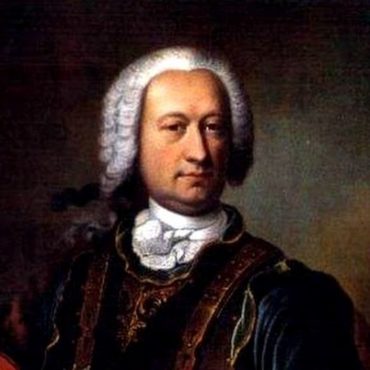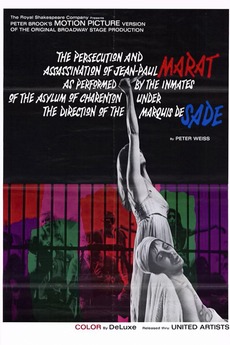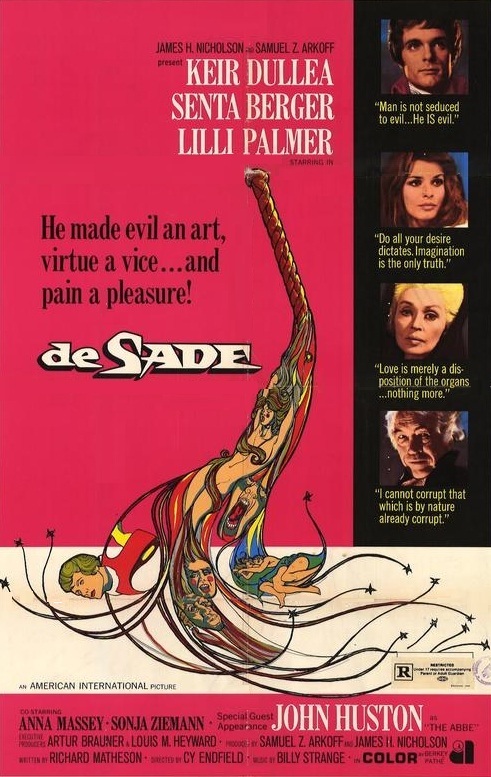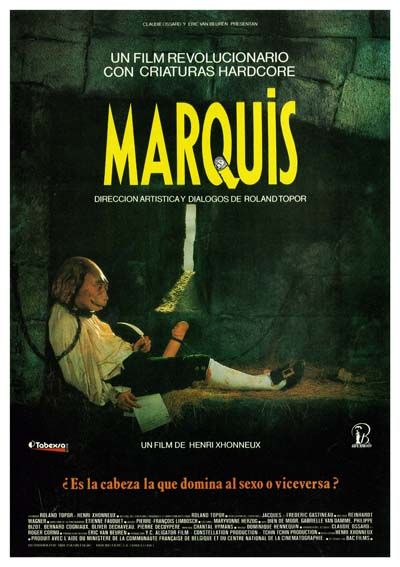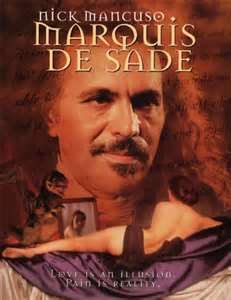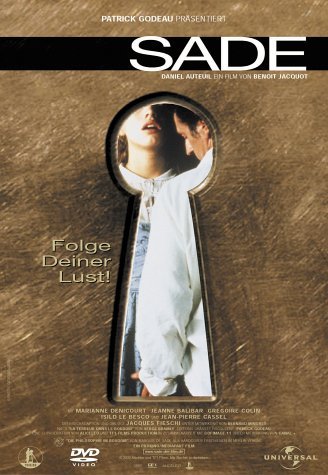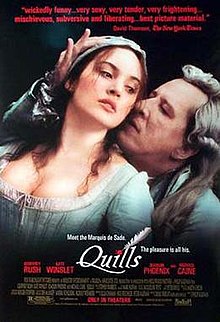The notorious Donatien Alphonse Francois, a.k.a. Marquis de Sade (1740-1814), is many things to many people. For proof just check out the numerous cinematic portrayals of the man, which are as varied as the films themselves.
The Marquis de Sade was a legendary libertine, as enumerated in the many biographies that have appeared over the years (my own favorite being the unique fictional-historical hybrid SATAN’S SAINT by WEREWOLF OF PARIS author Guy Endore). Sade’s taste for prostitutes is well documented, as was his penchant for violent sex (the word Sadism is derived from his name) and the frequent prison spells that took up a large portion of his life. Sade’s fiction was widely censored in its time, and his classic novels JUSTINE, JULIETTE, PHILOSOPHY IN THE BEDROOM and THE 120 DAYS OF SODOM remain potent exercises in literary excess.
The Marquis de Sade was a legendary libertine…
Cinematic versions of Sade’s fiction are legion (even though most—JUSTINE, BEYOND LOVE AND EVIL, SALO: THE 120 DAYS OF SODOM, etc.—are extremely loose adaptations) while biographical films are nearly as prevalent, and range in nationality from Sade’s native France to England to Hollywood, U.S.A. You’ll also find a wide variety of film types mentioned below, from art house prestige to tawdry exploitation. As to what is the “right” approach I’m not sure I or anyone else can honestly say, although I can assert that some of the following films are definitely better than others.
The British made MARAT/SADE (Full Title: THE PERSECUTION AND ASSASSINATION OF JEAN PAUL MARAT AS PERFORMED BY THE INMATES OF CHARENTON UNDER THE DIRECTION OF THE MARQUIS DE SADE) appeared in 1966. As with most of the following entries on this list, it’s anything but a straight biopic. It was also quite influential in its insane asylum setting, a facet that characterized nearly every Sade biopic that followed. Here that setting is the Charenton asylum in the early 1900’s, where Sade is directing a play with a cast of fellow inmates.
MARAT/SADE was adapted from the famous play by Peter Weiss and superbly directed by Peter Brook, recreating the unique staging his original stage production. The intrusion of wide shots and close-ups into the play’s kaleidoscopic action has been criticized, but the cinematography by David Watkin, with its handheld camerawork and dark-hued illumination, is astonishing.
The play-within-the-film concerns the assassination of the revolutionary propagandist Jean Paul Marat. Of course the production doesn’t go as planned, with performers periodically passing out or turning catatonic, the Marquis engaging in impromptu political discussions with his fellows and the asylum director frequently interrupting the action to scold the mischievous Sade. Inevitably the whole thing degenerates as the inmates lose all semblance of order and insanity reigns.
The performances by the Royal Shakespeare Company are worth noting, in particular Glenda Jackson (in her movie debut) and Patrick Magee as MdS. Their efforts result in what is likely the most convincing assortment of movie mental patients I’ve ever seen.
The AIP sponsored German co-production DE SADE followed in 1969. It features Keir Dullea (coming off 2001: A SPACE ODYSSEY) as Sade in an incoherent mishmash of historical psychedelia that tries, and fails, to ape the cinema of Federico Fellini. The script was by Richard Matheson, who claims it was rewritten against this wishes; for that matter, the entire film was apparently reedited from its original X-rated version to its current incarnation, which is hopelessly tame. The few striking images—a masked jury decked out in red cloaks, a woman disappearing into her clothes—are deflated by the cheap production design, dime store psychology and hammy performances from Dullea and his co-stars, who include a slumming John Huston.
Late-60’s indulgence at its worst!
Jumping ahead two decades we arrive at the French made MARQUIS (1990), which is, along with MARAT/SADE, the most interesting and ambitious film of the lot. It’s an all-puppet pastiche that ranks with cult classics like FORBIDDEN ZONE and MEET THE FEEBLES in its defiant originality and gleeful outrageousness.
As in most of the other films profiled here, MARQUIS’ Sade spends the movie imprisoned in an asylum, where he’s subject to the whims of a number of corrupt individuals and his own unchecked libido. All the characters are depicted as various animals, with the Marquis presented as a dog, his guard a rat and the prison governor a rooster.
The narrative involves a plot by the asylum’s overseers to frame the Marquis for a rape, but the real action occurs in the Marquis’ contradictory relationship with his talking penis, a chatty and insistent twerp that always wants to fuck something, be it an alluring maiden or a crack in a wall. Conceived and designed by the famed satirist Roland Topor, MARQUIS also features claymation segments illustrating the main character’s perverted fantasies, as well as much lascivious behavior from a bevy of sadomasochistic perverts.
Ultimately I’m not sure MARQUIS has a whole lot to say about Sade that hasn’t been said elsewhere, but it is a classic of sorts.
1997’s Roger Corman executive produced MARQUIS DE SADE, by contrast, is trashy straight-to-video fodder through and through (with no puppets, sadly). As played by Nick Mancuso, this film’s “Divine Marquis” is a muscle-bound stud more in line with a Hollywood action movie hero than an 18th Century French writer.
The details of Sade’s life are given scant lip service in this faux-biography, which in true exploitation movie fashion favors sex and violence over historic detail–which might not have been such a bad thing if only the film were better made. It’s packed with nudity, yes, but the sexuality is strictly of the RED SHOE DIARIES variety (meaning a lot of heavy breathing amid smoke-filled interiors), and never very arousing. Thus the film fails miserably as a history lesson, and nor does it quite succeed as exploitation.
Next came 1999’s SADE, a comparatively subdued French made look at Sade’s final days. It’s very much in the mode of the following year’s QUILLS (see below) in conception and execution, though far more lugubrious overall. It has the Marquis (Daniel Auteuil) confined to an aristocratic sanitarium, where he seduces a naïve virgin (Isil Le Besco) while consorting with his former mistress (Marianne Denicort).
As directed by Benoit Jacquot the proceedings are strikingly realistic but also extremely dull. The film could have done with a bit more naughtiness, as all we really get in the way of sadean sexuality is a subdued bit of S&M. The Marquis all the while is portrayed as essentially a nice guy stuck with a bad rap, over which I much prefer the flamboyant Sades of MARAT/SADE and MARQUIS.
The American made QUILLS turned up in 2000. It’s far from great, but at least boasts solid performances from Geoffrey Rush as MdS and Kate Winslet (whose post-TITANIC clout reportedly got the film made) as the servant who smuggled Sade’s writings out of the Charenton asylum where he spent his final years. The direction by the sometimes-great Philip Kaufman is by turns deep and playful, but usually always compelling.
Yet Kaufman is a filmmaker who came of age in the 1960s, which would seem to explain why QUILLS’ Sade is so Timothy Leary-esque. Nor are the wimpy prose excerpts presented by screenwriter Doug Wright at all convincing as Sade imaginings; the Marquis was a writer, let’s not forget, who (in JULIETTE) described a woman using a man’s plucked-out heart as a masturbation device, something the dilettante depicted here would seem incapable of conceiving.
Another thing: although it’s set in France, everyone in this film speaks in English accents. This is standard procedure in Hollywood, wherein “historical” movies always seem to involve stiff-lipped British accented performers, but has little connection to reality, and even less to that of the Marquis de Sade.

